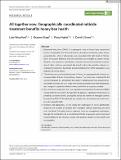All together now : geographically coordinated miticide treatment benefits honey bee health
Abstract
Deformed wing virus (DWV) is a pathogenic virus of honey bees transmitted by the ectoparasitic mite Varroa destructor. Annual overwintering colony losses, accounting for ~25% of all colonies, are associated with high levels of Varroa-DWV infestation. Effective miticide treatments are available to control Varroa. However, the absence of coordinated treatment means environmental transmission of mites continues unchecked. We aimed to determine whether rational, coordinated treatment is beneficial, and characterized the DWV population as an indicator of colony health. This study uses coordinated treatment of Varroa in a geographically isolated environment (Isle of Arran, Scotland) over 3 years. The study area contained 50–84 colonies managed by ~20 amateur beekeepers. Sampling and virus analysis to assess strain diversity and viral loads were conducted before and after treatments, and changes in population diversity were quantified by sequence analysis. Over the 3 years analysis of the virus population revealed that the dominant DWV variant shifted from Type A to Type B in all apiaries, regardless of mite levels or proximity to other colonies. During this period the number of managed colonies increased by 47% (57–84 colonies), but despite this, we estimate total mite numbers decreased by 58%. Synthesis and applications. In this study, the beekeepers in Arran significantly improved the number of colonies they managed, without importing any bees onto the island, indicating that an improved focus on management techniques, through the combination of a coordinated miticide programme and an improved understanding of bee diseases, could yield positive results for bee health and sustainability.
Citation
Woodford , L , Sharpe , G , Highet , F & Evans , D J 2023 , ' All together now : geographically coordinated miticide treatment benefits honey bee health ' , Journal of Applied Ecology , vol. 60 , no. 5 , pp. 790-802 . https://doi.org/10.1111/1365-2664.14367
Publication
Journal of Applied Ecology
Status
Peer reviewed
ISSN
0021-8901Type
Journal article
Description
Funding: This research was funded by the BBSRC (Biotechnology and Biological Sciences Research Council), grant number: BB/M010996/1.Collections
Items in the St Andrews Research Repository are protected by copyright, with all rights reserved, unless otherwise indicated.

